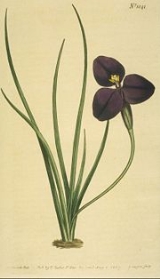
Patersonia
Encyclopedia
Patersonia is a genus of the Iridaceae
with about 20 species in Australia
and several in the Malesian
region. The genus name is a tribute to the first Lieutenant Governor of New South Wales
in Australia, William Paterson
.
They are perennials with basal leaves growing from a woody rhizome that in some species extends above ground to form a short trunk. The leaves are tough and fibrous with various adaptations to conserve moisture: stomata sunk in grooves, thickened cross-section, marginal hairs or thickened margins.
The flowers appear from between a pair of bracts on a leafless stem. They have three large outer tepals that are usually blue to violet, and three tiny inner tepals. There are three stamens fused at the base to form a tube around the longer style which bears a flattened stigma.
Several Patersonia species are grown as garden subjects. They can be propagated by seed or by division.
Iridaceae
The Iris family or Iridaceae is a family of perennial, herbaceous and bulbous plants included in the monocot order Asparagales, taking its name from the genus Iris. Almost worldwide in distribution and one of the most important families in horticulture, it includes more than 2000 species...
with about 20 species in Australia
Australia
Australia , officially the Commonwealth of Australia, is a country in the Southern Hemisphere comprising the mainland of the Australian continent, the island of Tasmania, and numerous smaller islands in the Indian and Pacific Oceans. It is the world's sixth-largest country by total area...
and several in the Malesian
Malesia
Malesia is a biogeographical region straddling the boundaries of the Indomalaya ecozone and Australasia ecozone, and also a phytogeographical floristic region in the Paleotropical Kingdom.-Floristic province:...
region. The genus name is a tribute to the first Lieutenant Governor of New South Wales
New South Wales
New South Wales is a state of :Australia, located in the east of the country. It is bordered by Queensland, Victoria and South Australia to the north, south and west respectively. To the east, the state is bordered by the Tasman Sea, which forms part of the Pacific Ocean. New South Wales...
in Australia, William Paterson
William Paterson (explorer)
Colonel William Paterson, FRS was a Scottish soldier, explorer, Lieutenant governor and botanist best known for leading early settlement in Tasmania. This botanist is denoted by the author abbreviation Paterson when citing a botanical name.-Early years:A native of Montrose, Scotland, Paterson was...
.
They are perennials with basal leaves growing from a woody rhizome that in some species extends above ground to form a short trunk. The leaves are tough and fibrous with various adaptations to conserve moisture: stomata sunk in grooves, thickened cross-section, marginal hairs or thickened margins.
The flowers appear from between a pair of bracts on a leafless stem. They have three large outer tepals that are usually blue to violet, and three tiny inner tepals. There are three stamens fused at the base to form a tube around the longer style which bears a flattened stigma.
Several Patersonia species are grown as garden subjects. They can be propagated by seed or by division.
- Patersonia fragilisPatersonia fragilisPatersonia fragilis is a perennial herbaceous plant that is native to Southeastern Australia....
comes from sandy coastal heathlands in south-eastern Australia; it has narrow grey-green leaves and pale violet flowers close to the ground.
- Patersonia glabrata forms a shrub to 80 cm high with wiry tangled stems.
- Patersonia occidentalis (native iris) to 75 cm tall with blue flowers, widespread in southern Australia.
- Patersonia sericea is similar but has bracts covered in short silky hairs. It is an east coast species, replaced by the closely related P. rudis and P. lanata in Western AustraliaWestern AustraliaWestern Australia is a state of Australia, occupying the entire western third of the Australian continent. It is bounded by the Indian Ocean to the north and west, the Great Australian Bight and Indian Ocean to the south, the Northern Territory to the north-east and South Australia to the south-east...
and P. macrantha in the Northern TerritoryNorthern TerritoryThe Northern Territory is a federal territory of Australia, occupying much of the centre of the mainland continent, as well as the central northern regions...
.
- Patersonia umbrosa from Western Australia has two colour variants, the typical blue-violet variety, and the yellow-flowered var. xanthina from the karriKarriEucalyptus diversicolor, commonly known as the Karri, is a eucalypt which is native to the wetter regions of south west of Western Australia.-Description:...
forests.

